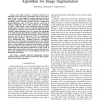Free Online Productivity Tools
i2Speak
i2Symbol
i2OCR
iTex2Img
iWeb2Print
iWeb2Shot
i2Type
iPdf2Split
iPdf2Merge
i2Bopomofo
i2Arabic
i2Style
i2Image
i2PDF
iLatex2Rtf
Sci2ools
TIP
2008
2008
A Scale-Based Connected Coherence Tree Algorithm for Image Segmentation
This paper presents a connected coherence tree algorithm (CCTA) for image segmentation with no prior knowledge. It aims to find regions of semantic coherence based on the proposed -neighbor coherence segmentation criterion. More specifically, with an adaptive spatial scale and an appropriate intensity-difference scale, CCTA often achieves several sets of coherent neighboring pixels which maximize the probability of being a single image content (including kinds of complex backgrounds). In practice, each set of coherent neighboring pixels corresponds to a coherence class (CC). The fact that each CC just contains a single equivalence class (EC) ensures the separability of an arbitrary image theoretically. In addition, the resultant CCs are represented by tree-based data structures, named connected coherence tree (CCT)s. In this sense, CCTA is a graph-based image analysis algorithm, which expresses three advantages: (1) its fundamental idea, -neighbor coherence segmentation criterion, is e...
-neighbor Coherence Segmentation | Coherence Segmentation Criterion | Coherent Neighboring Pixels | TIP 2008 |
Related Content
| Added | 15 Dec 2010 |
| Updated | 15 Dec 2010 |
| Type | Journal |
| Year | 2008 |
| Where | TIP |
| Authors | Jundi Ding, RuNing Ma, Songcan Chen |
Comments (0)

